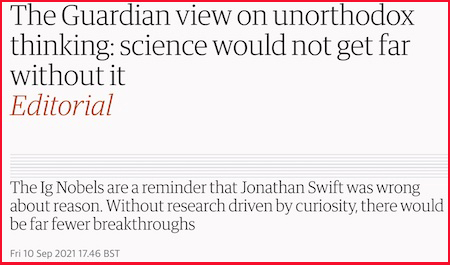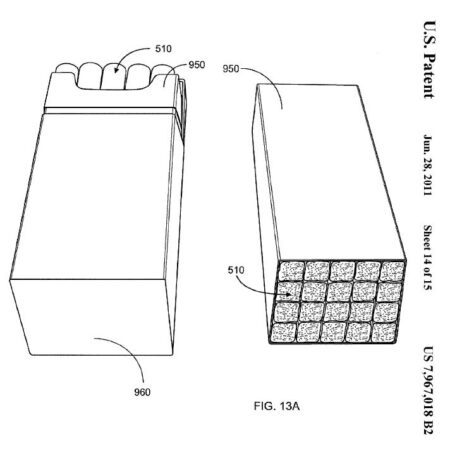Marc Abrahams's Blog, page 72
September 13, 2021
YouTube, the Ig Nobel Prizes, and the Year 1914
YouTube’s notorious takedown algorithms are blocking the video of the 2021 Ig Nobel Prize ceremony.
We have so far been unable to find a human at YouTube who can fix that. We recommend that you watch the identical recording on Vimeo.
The Fatal Song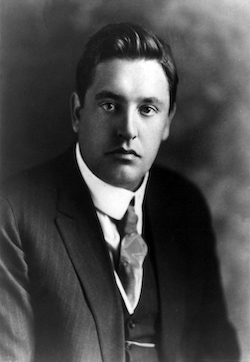
This is a photo of John McCormack, who sang the song “Funiculi, Funicula” in the year 1914, inducing YouTube to block the 2021 Ig Nobel Prize ceremony.
Here’s what triggered this: The ceremony includes bits of a recording (of tenor John McCormack singing “Funiculi, Funicula”) made in the year 1914.
The Corporate TakedownYouTube’s takedown algorithm claims that the following corporations all own the copyright to that audio recording that was MADE IN THE YEAR 1914: “SME, INgrooves (on behalf of Emerald); Wise Music Group, BMG Rights Management (US), LLC, UMPG Publishing, PEDL, Kobalt Music Publishing, Warner Chappell, Sony ATV Publishing, and 1 Music Rights Societies”
UPDATE (Sept 13): There’s an ongoing discussion, in Hacker News, about this problem.

September 12, 2021
Science, Jonathan Swift, and the Ig Nobel Prizes
A September 11, 2021 editorial in The Guardian focuses on the Ig Nobel Prizes, Jonathan Swift, and science, though not necessarily in that order:
The editorial begins:
On the other hand or hands
In Gulliver’s Travels, Jonathan Swift mocked the assumption that the scientific revolution had transformed European culture for the better. The satirical novel, published in 1726, has its eponymous hero stumbling upon “the Academy” in the fictional city of Lagado, and pokes fun at the idea that a scientific temperament could be useful. Swift describes pointless experiments to extract sunbeams from cucumbers and to build houses from the roof downwards. His book is laced with sardonic wit. But unorthodox, even absurd, thinking is necessary for science to progress.
That point has been underlined by this week’s winners of the Ig Nobel prize, established in 1991…
To see some alternative takes on the Ig Nobel Prizes, dip into a wee collection of press reports, from yon and hither, about them.

September 9, 2021
Announcing the 2021 Ig Nobel Prize winners
The 2021 Ig Nobel Prizes were awarded at the 31st First Annual Ig Nobel Prize ceremony, on Thursday, September 9, 2021. Each winner has done something that makes people LAUGH, then THINK.
Because of the Covid-19 pandemic, the ceremony happened entirely online, rather than in its traditional home, Sanders Theatre at Harvard University. You can watch a recording of that webcast.
The 2021 Ig Nobel Prize winnersBIOLOGY PRIZE [SWEDEN]:
Susanne Schötz for analyzing variations in purring, chirping, chattering, trilling, tweedling, murmuring, meowing, moaning, squeaking, hissing, yowling, howling, growling, and other modes of cat–human communication.
REFERENCE: “A Comparative Acoustic Analysis of Purring in Four Cats,” Susanne Schötz and Robert Eklund, Proceedings of Fonetik 2011, Speech, Music and Hearing, KTH, Stockholm, TMH-QPSR, 51.
REFERENCE: “A Phonetic Pilot Study of Vocalisations in Three Cats,” Susanne Schötz, Proceedings of Fonetik 2012, Department of Philosophy, Linguistics and Theory of Science, University of Gothenburg, Sweden.
REFERENCE: “A Phonetic Pilot Study of Chirp, Chatter, Tweet and Tweedle in Three Domestic Cats,” Susanne Schötz, Proceedings of Fonetik 2013, Linköping University, Sweden, 2013, pp. 65-68.
REFERENCE: “A Study of Human Perception of Intonation in Domestic Cat Meows,” Susanne Schötz and Joost van de Weijer, Proceedings of the 7th International Conference on Speech Prosody, Dubin, Ireland, May 20-23, 2014.
REFERENCE: “Melody in Human–Cat Communication (Meowsic): Origins, Past, Present and Future,” Susanne Schötz, Robert Eklund, and Joost van de Weijer, 2016.
WHO TOOK PART IN THE CEREMONY: Susanne Schötz
ECOLOGY PRIZE [SPAIN. IRAN]:
Leila Satari, Alba Guillén, Àngela Vidal-Verdú, and Manuel Porcar, for using genetic analysis to identify the different species of bacteria that reside in wads of discarded chewing gum stuck on pavements in various countries.
REFERENCE: “The Wasted Chewing Gum Bacteriome,” Leila Satari, Alba Guillén, Àngela Vidal-Verdú, and Manuel Porcar, Scientific Reports, vol. 10, no. 16846, 2020.
WHO TOOK PART IN THE CEREMONY: Leila Satari, Alba Guillén, Àngela Vidal-Verdú, Manuel Porcar
CHEMISTRY PRIZE [GERMANY, UK, NEW ZEALAND, GREECE, CYPRUS, AUSTRIA]:
Jörg Wicker, Nicolas Krauter, Bettina Derstroff, Christof Stönner, Efstratios Bourtsoukidis, Achim Edtbauer, Jochen Wulf, Thomas Klüpfel, Stefan Kramer, and Jonathan Williams, for chemically analyzing the air inside movie theaters, to test whether the odors produced by an audience reliably indicate the levels of violence, sex, antisocial behavior, drug use, and bad language in the movie the audience is watching.
REFERENCE: “Proof of Concept Study: Testing Human Volatile Organic Compounds as Tools for Age Classification of Films,” Christof Stönner, Achim Edtbauer, Bettina Derstroff, Efstratios Bourtsoukidis, Thomas Klüpfel, Jörg Wicker, and Jonathan Williams, PLoS ONE, vol. 13, no. 10, 2008, p. e0203044.
REFERENCE: “Cinema Data Mining: The Smell of Fear,” Jörg Wicker, Nicolas Krauter, Bettina Derstorff, Christof Stönner, Efstratios Bourtsoukidis, Thomas Klüpfel, Jonathan Williams, and Stefan Kramer, Proceedings of the 21th ACM SIGKDD International Conference on Knowledge Discovery and Data Mining, pp. 1295-1304. 2015.
WHO TOOK PART IN THE CEREMONY: Jörg Wicker, Nicolas Krauter, Bettina Derstroff, Christof Stönner, Efstratios Bourtsoukidis, Achim Edtbauer, Jochen Wulf, Thomas Klüpfel, Stefan Kramer, Jonathan Williams
ECONOMICS PRIZE [FRANCE, SWITZERLAND, AUSTRALIA, AUSTRIA, CZECH REPUBLIC, UK]:
Pavlo Blavatskyy, for discovering that the obesity of a country’s politicians may be a good indicator of that country’s corruption.
REFERENCE: “Obesity of Politicians and Corruption in Post‐Soviet Countries,” Pavlo Blavatskyy, Economic of Transition and Institutional Change, vol. 29, no. 2, 2021, pp. 343-356.
WHO TOOK PART IN THE CEREMONY: Pavlo Blavatskyy
MEDICINE PRIZE [GERMANY, TURKEY, UK]:
Olcay Cem Bulut, Dare Oladokun, Burkard Lippert, and Ralph Hohenberger, for demonstrating that sexual orgasms can be as effective as decongestant medicines at improving nasal breathing.
REFERENCE: “Can Sex Improve Nasal Function? — An Exploration of the Link Between Sex and Nasal Function,” Olcay Cem Bulut, Dare Oladokun, Burkard M. Lippert, and Ralph Hohenberger, Ear, Nose & Throat Journal, 2021, no. 0145561320981441.
WHO TOOK PART IN THE CEREMONY: Olcay Cem Bulut, Dare Oladokun, Ralph Hohenberger
PEACE PRIZE [USA]:
Ethan Beseris, Steven Naleway, and David Carrier, for testing the hypothesis that humans evolved beards to protect themselves from punches to the face.
REFERENCE: “Impact Protection Potential of Mammalian Hair: Testing the Pugilism Hypothesis for the Evolution of Human Facial Hair,” Ethan A. Beseris, Steven E. Naleway, David R. Carrier, Integrative Organismal Biology, vol. 2, no. 1, 2020, obaa005.
WHO TOOK PART IN THE CEREMONY: Ethan Beseris, Steven Naleway, David Carrier
PHYSICS PRIZE [THE NETHERLANDS, ITALY, TAIWAN, USA]:
Alessandro Corbetta, Jasper Meeusen, Chung-min Lee, Roberto Benzi, and Federico Toschi, for conducting experiments to learn why pedestrians do not constantly collide with other pedestrians.
REFERENCE: “Physics-based modeling and data representation of pairwise interactions among pedestrians,” Alessandro Corbetta, Jasper A. Meeusen, Chung-min Lee, Roberto Benzi, and Federico Toschi, Physical Review E, vol. 98, no. 062310, 2018.
WHO TOOK PART IN THE CEREMONY: Alessandro Corbetta, Jasper Meeusen, Chung-min Lee, Roberto Benzi,, Federico Toschi
KINETICS PRIZE [JAPAN, SWITZERLAND, ITALY]:
Hisashi Murakami, Claudio Feliciani, Yuta Nishiyama, and Katsuhiro Nishinari, for conducting experiments to learn why pedestrians do sometimes collide with other pedestrians.
REFERENCE: “Mutual Anticipation Can Contribute to Self-Organization in Human Crowds,” Hisashi Murakami, Claudio Feliciani, Yuta Nishiyama, and Katsuhiro Nishinari, Science Advances, vol. 7, no. 12, 2021, p. eabe7758.
WHO TOOK PART IN THE CEREMONY: Hisashi Murakami, Claudio Feliciani, Yuta Nishiyama, Katsuhiro Nishinari
ENTOMOLOGY PRIZE [USA]:
John Mulrennan, Jr., Roger Grothaus, Charles Hammond, and Jay Lamdin, for their research study “A New Method of Cockroach Control on Submarines”.
REFERENCE: “A New Method of Cockroach Control on Submarines,” John A. Mulrennan, Jr., Roger H. Grothaus, Charles L. Hammond, and Jay M. Lamdin, Journal of Economic Entomology, vol. 64, no. 5, October 1971, pp. 1196-8.
WHO TOOK PART IN THE CEREMONY: John Mulrennan, Jr.
TRANSPORTATION PRIZE [NAMIBIA, SOUTH AFRICA, TANZANIA, ZIMBABWE, BRAZIL, UK, USA]:
Robin Radcliffe, Mark Jago, Peter Morkel, Estelle Morkel, Pierre du Preez, Piet Beytell, Birgit Kotting, Bakker Manuel, Jan Hendrik du Preez, Michele Miller, Julia Felippe, Stephen Parry, and Robin Gleed, for determining by experiment whether it is safer to transport an airborne rhinoceros upside-down.
REFERENCE: “The Pulmonary and Metabolic Effects of Suspension by the Feet Compared with Lateral Recumbency in Immobilized Black Rhinoceroses (Diceros bicornis) Captured by Aerial Darting,” Robin W. Radcliffe, Mark Jago, Peter vdB Morkel, Estelle Morkel, Pierre du Preez, Piet Beytell, Birgit Kotting, Bakker Manuel, Jan Hendrik du Preez, Michele A. Miller, Julia Felippe, Stephen A Parry; R.D. Gleed, Journal of Wildlife Diseases, vol. 57, no. 2, 2021, 357–367.
WHO TOOK PART IN THE CEREMONY: Pete Morkel, Mark Jago, Robin Gleed, Robin Radcliffe
Most of the new winners will give free public talks to explain, if they can, what they did and why they did it.
These talks, the Ig Informal Lectures, will be presented one at a time, over the coming weeks. Because of the Covid-19 pandemic, this year’s lectures will be presented online, here at www.improbable.com, rather than in a lecture hall in their usual home, MIT (the Massachusetts Institute of Technology).

September 7, 2021
The 2021 Ig Nobel Prize Ceremony webcast
The 31st First Annual Ig® Nobel Prize ceremony happens Thursday, September 9, 2021, at 6 pm (US eastern time). Watch it right here. Alternatively, watch the Japanese webstream, or the Chinese webstream.
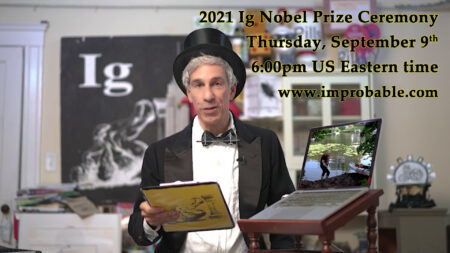
Ten new Ig Nobel prizes will be awarded for things that make people LAUGH, then THINK. The ceremony web page has plentiful background details.
If you tweet, please add the hashtag #IgNobel to your tweets.

A Zigzaging Look at Viagra Uses, from Zagazig University
Zagazig University adds to the growing pool of information about the drug known as Viagra:
“Sildenafil: from angina to SARS-CoV-2 [Sildénafil: de l’angine au SARS-CoV-2],” Ghada M. Khairy, Sawsan M.A. El-Sheikh, Naglaa Z. Eleiwa, and Azza A.A. Galal, Sexologies, epub 2021.

The authors, at the Department of Pharmacology, Zagazig University, Egypt, report:
Sildenafil was first examined as an alternative to nitrates for the management of angina pectoris and hypertension and eventually developed into an oral therapeutic agent used for the treatment of erectile dysfunction…. Here we review fundamental highlights in the enhancement of sildenafil for numerous scientific disorders and consider practicable new uses for this versatile drug.

September 6, 2021
Embodying a new cross-sectional paradigm for a smokable rod [square cigarettes patent]
“A cigarette typically is employed by a smoker by lighting one end thereof and burning the tobacco rod. The smoker then receives mainstream smoke into his/her mouth by drawing on the opposite end (e.g., the filter end) of the cigarette.”
– explains a patent granted to Big Tobacco giant R.J. Reynolds.
U.S. patent 7,967,018 B2, issued June 28, 2011, stuck broadly to the traditional approach outlined above – but described a new variant. The cigarettes are square rather than round.
“It would be highly desirable to provide manners and methods, and associated equipment, for producing smoking articles, such as filtered cigarettes, that have a cross-sectional shape that can be characterized as not being generally circular or oval in nature.”
The patent fails to clarify (at least at first-glance to a non-expert) why the production of square cigarettes would be “highly desirable”, and what might be the possible advantages of square cigarettes.
COMING SOON : The possible advantages of square cigarettes
Note : Previous patents have been granted for non-circular cigarettes – see for example, Daniel J. Campbell’s Oval Cigarette (1897) S.C. Miller’s square cigarettes (1931) George A, Shouse’s triangular and ‘squovoid’ ( squarishly oval) cigarettes (1994)
Patent Research Martin Gardiner

September 4, 2021
Ig Nobel Prizes in the LA Times Crossword Puzzle
The Ig Nobel Prizes have again turned up in a crossword puzzle, this time as a clue in the September 4, 2021 puzzle in The Los Angeles Times. The clue for one of the across words is:
22 The Ig Nobel Prize, e.g.
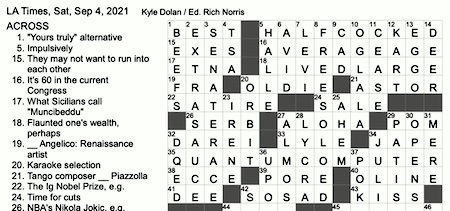
By our lazy count, this is the fifth time the Ig Nobel Prizes have appeared in a major crossword puzzle (if there is such a thing as a major crossword puzzle) in an English-language publication. The Week used it in their puzzle on October 19, 2015. The New York Times used it in their puzzle on December 20, 2020. The Wall Street Journal used it in their puzzle January 23, 2021. The New Yorker used it in their puzzle April 5, 2021.
The Igs have also been an answer on the Jeopardy! TV program eight times or so.
(Thanks to Martin Eiger for bringing this to our attention.)

September 3, 2021
2012 Japanese Ig Nobel Prize-winning Invention Patented by US Navy in 2021
The US Navy has obtained a patent (US patent #11082763, “Handheld acoustic hailing and disruption systems and methods”), here in the year 2021, for a device essentially the same as the invention that earned an Ig Nobel Prize in the year 2012 for a team of Japanese inventors.
Unsound Invention, AnewNew Scientist magazine reports on the new patent, with the headline “Sneaky US Navy feedback device could stop people being able to speak“. Here is a technical drawing from that new patent:
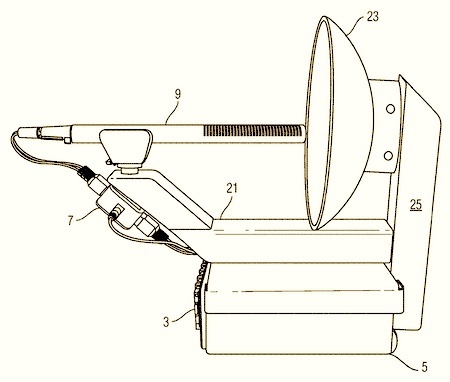
The 2012 Ig Nobel Prize for acoustics was awarded to Kazutaka Kurihara and Koji Tsukada, for creating the SpeechJammer — a machine that disrupts a person’s speech, by making them hear their own spoken words at a very slight delay.
Kurihara and Koji Tsukada documented their research, in the study “SpeechJammer: A System Utilizing Artificial Speech Disturbance with Delayed Auditory Feedback“, Kazutaka Kurihara, Koji Tsukada, arxiv.org/abs/1202.6106. February 28, 2012. They also produced this explanatory video:
(Thanks to Neil Judell for bringing the new patent to our attention.)
A Peaceful Echo, Sort of, From the Year 2000This US naval reinvention sounds distantly related, in an upside-down way, to the inventive use of sound that earned the Ig Nobel Peace Prize in the year 2000, for the British Royal Navy. The British Royal Navy was honored, that year, for ordering its sailors to stop using live cannon shells, and to instead just shout “Bang!”

September 2, 2021
One week from today: The 2021 Ig Nobel Prize Ceremony
The 2021 Ig Nobel Prize ceremony webcast happens one week from today: on Thursday, September 9. The ceremony web page has details about who will present the prizes, who will deliver this year’s 24/7 Lectures, about the new mini-opera, the paper airplanes, and all that.
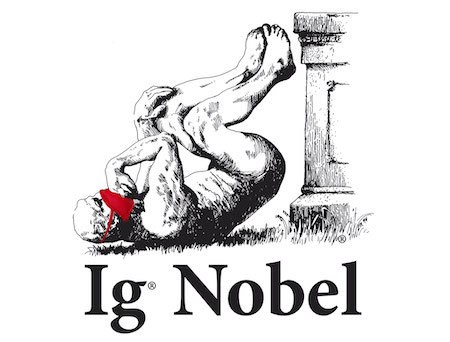
The ceremony live stream will be in the traditional English language. There will also be a special streams in Japanese and Chinese. And we expect (but it’s not certain yet) there will also be a special Spanish-language stream.

Coronal Kimchee-and-the-Nose Investigation
Kimchee, hot soup, and nose filters all figure in the search for understanding and containment of the Covid-19 pandemic. They figure especially highly in this newly published study:
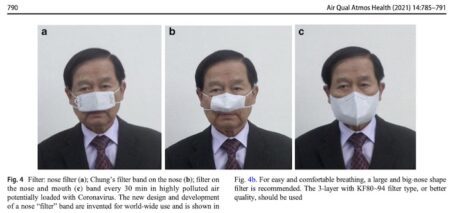
“Assessment of Coronavirus disease, the nose pollution filter, fermented spicy Kimchee, and peppery hot soup consumed in Korea,” Y. S. Chung, Air Quality, Atmosphere & Health, vol. 14, 2021, pp. 785–791. (Thanks to Tom Gill for bringing this to our attention.)
HAVE PDF. GOOD FIGURE 4
https://link.springer.com/article/10....

Marc Abrahams's Blog
- Marc Abrahams's profile
- 14 followers


